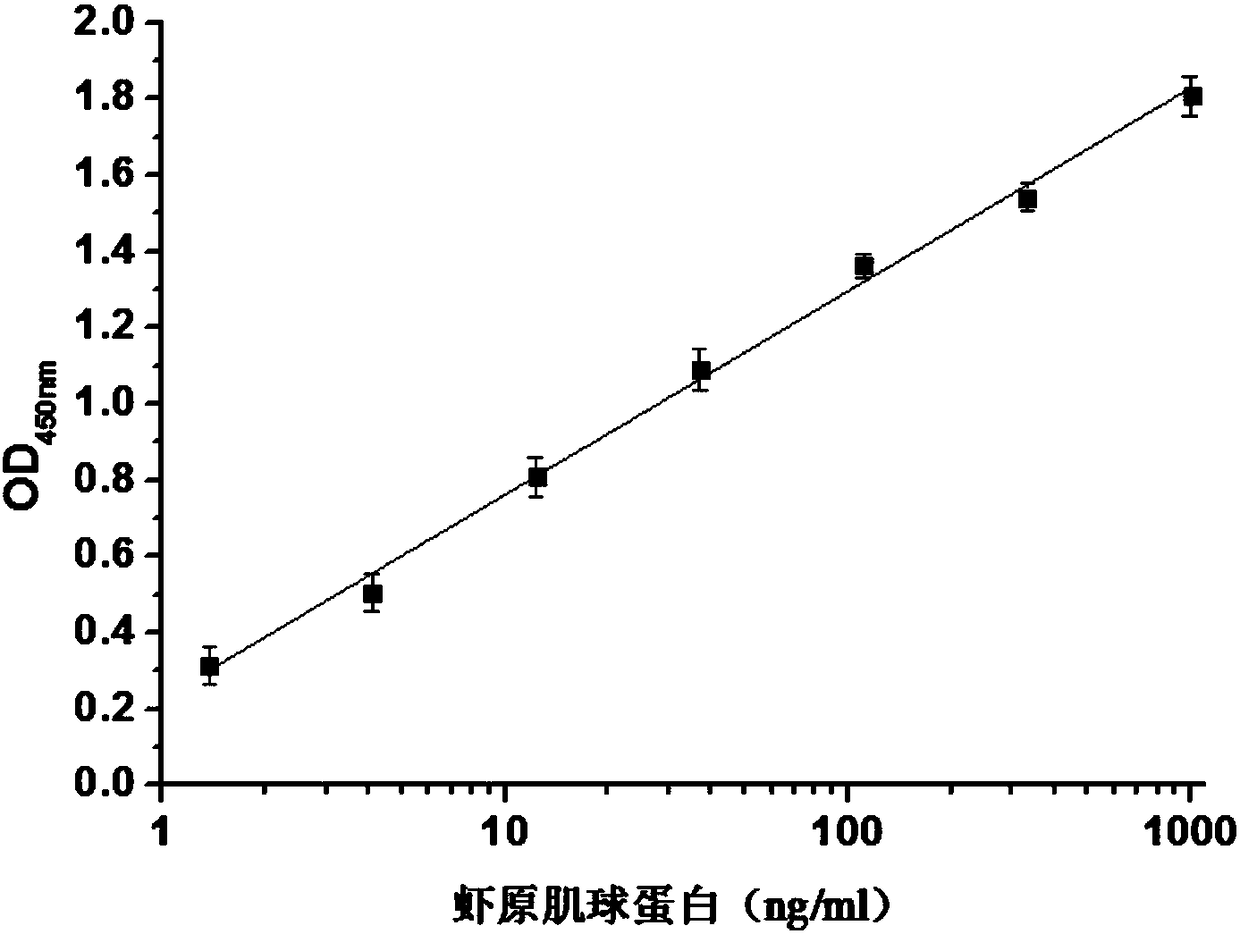Hybridoma cells of shrimp tropomyosin monoclonal antibodies and application thereof
A tropomyosin and monoclonal antibody technology, applied in the field of hybridoma cells, can solve problems such as restricting the development of allergen detection methods, high cost, and requiring specific analytical instruments for detection.
- Summary
- Abstract
- Description
- Claims
- Application Information
AI Technical Summary
Problems solved by technology
Method used
Image
Examples
Embodiment 1
[0035] The monoclonal antibody preparation of embodiment 1 shrimp tropomyosin
[0036] 1. Preparation of shrimp tropomyosin allergen:
[0037] a. Preparation of shrimp protein extract: Weigh 20 g of peeled shrimp, and process it with a tissue masher to obtain shrimp meat paste. Shrimp paste was immersed in petroleum ether (60-90) at a ratio of 1:10 (W / V) to degrease, stirred overnight at 4°C, centrifuged at 6000 r / min for 15 minutes, discarded the supernatant, and placed the precipitate in a fume hood to evaporate the petroleum ether. Skim shrimp. Immediately immerse in 0.05M pH7.4PBS at a ratio of 1:20 (W / V) for overnight extraction, centrifuge the extract at 7000r / min for 20min at 4°C, discard the precipitate, and the supernatant is the shrimp protein extract.
[0038] b. Fractional precipitation of ammonium sulfate: slowly add saturated ammonium sulfate solid into the shrimp protein extract, stir while adding, until the saturation is 30%, let it stand at 4°C for 1h, centr...
Embodiment 2
[0056] The establishment of embodiment 2 double antibody sandwich ELISA:
[0057] 1) Coating: Coat the microtiter plate with the antibody of cell line number FB12-1 at a concentration of 4 μg / mL, 100 μL / well, overnight at 4 °C;
[0058] 2) Washing: Wash the reaction plate three times with PBST, 3 min each time, 200 μL / well, and then dry the reaction plate;
[0059] 3) Blocking: add 200 μL / well blocking solution, and incubate at 37°C for 2 hours;
[0060] 4) washing: same as 2);
[0061] 5) Sample: Shrimp tropomyosin was diluted to 1 μg / mL with PBS, and then three-fold for serial dilution; another PBS blank control was set. Add 100 μL sample to each well and incubate at 37°C for 1 hour;
[0062] 6) washing: same as 2);
[0063] 7) Add enzyme-labeled antibody (7H6-HRP, 2 μg / mL), 100 μL / well, react at 37°C for 1 hour;
[0064] 8) washing: same as 2);
[0065] 9) Color development: add substrate TMB 100 μL / well, and develop color for 12 minutes;
[0066] 10) Termination: Ad...
Embodiment 3
[0069] Taking shrimp samples as an example to detect the allergenic component shrimp tropomyosin
[0070] 1) Coating: Dilute the mouse anti-shrimp tropomyosin monoclonal antibody to the coating concentration with the coating solution, add 100 μL / well to the microtiter plate, and overnight at 4 °C;
[0071] 2) Washing: Discard the liquid in the wells of the microplate, wash the reaction plate three times with PBST, each time for 3 minutes, 200 μL / well, and then dry the reaction plate;
[0072] 3) Blocking: add 200 μL / well blocking solution, and incubate at 37°C for 2 hours;
[0073] 4) washing: same as 2);
[0074] 5) Sample: gradiently dilute shrimp tropomyosin with sample diluent, and dilute the sample to be tested appropriately, 100 μL per well, set positive control and negative control, and incubate at 37°C for 1 hour;
[0075] 6) washing: same as 2);
[0076] 7) Add enzyme-labeled antibody: Dilute the enzyme-labeled mouse anti-shrimp tropomyosin antibody to the working ...
PUM
| Property | Measurement | Unit |
|---|---|---|
| molecular weight | aaaaa | aaaaa |
Abstract
Description
Claims
Application Information
 Login to View More
Login to View More - R&D
- Intellectual Property
- Life Sciences
- Materials
- Tech Scout
- Unparalleled Data Quality
- Higher Quality Content
- 60% Fewer Hallucinations
Browse by: Latest US Patents, China's latest patents, Technical Efficacy Thesaurus, Application Domain, Technology Topic, Popular Technical Reports.
© 2025 PatSnap. All rights reserved.Legal|Privacy policy|Modern Slavery Act Transparency Statement|Sitemap|About US| Contact US: help@patsnap.com

